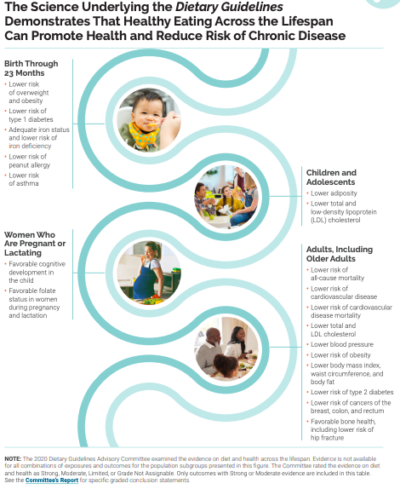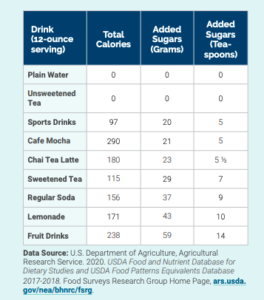The first set of Dietary Guidelines for Americans was published in 1980. Every five years they are reviewed and updated. The 2020-2025 version have now been released. Every five years these guidelines are reviewed by an expert committee, then approved by the USDA and the HHS (Health and Human Services) to determine the dietary parameters for a healthy dietary pattern.
Read the full report here.
Repetition Leads to Learning
How much has changed? Well, not much really.
The biggest changes from the 2015 version is a focus on embracing personal and cultural food preferences, and focusing on nutrition from pregnancy through age two. The new guidelines also include a better summary for older adults over the age of sixty. In addition, I found the overall messages of inclusion encouraging.
Only about 56-60% of Americans actually follow the Dietary Guidelines. Perhaps repetition can lead to learning. Click To TweetThere are always groups that complain about the Guidelines. The bottom line – they outline simple, balanced, healthy eating. If more people followed this sort of pattern, we’d have a healthier nation.
Make Every Bite Count
The goal of having a national set of dietary guidelines is to inform public health policy, thereby helping every American thrive and lead healthier lives. Good food leads to good health. The tagline, Make Every Bite Count, encourages Americans to choose the right amount of nutrient dense food. The overall Guidelines however, reflect the current science about the link diet has to health and disease.
The goal of having a national set of dietary guidelines is to inform public health policy, thereby helping every American thrive and lead healthier lives. Good food leads to good health.
Nutrition professionals have always known that healthy dietary patterns helps to manage weight, cardiovascular disease and diabetes. We also know that poor dietary patterns can lead to some cancers, and that good nutrition helps to support a strong body.
The guidelines continue to encourage a greater intake of vegetables (fresh, frozen or canned), whole fruit (fresh, canned, frozen or dried), and grains (choosing whole grains for half of your grains).
Follow a healthy dietary pattern at every life stage.
Evidence has been building to support the significance of quality nutrition during the first 1000 days. How well a baby is nourished from conception through age 2 has a huge impact on his or her future health. With 90% of brain growth happening before kindergarten, you really do want to make every bite count.
Introducing a variety of foods early can also reduce allergies. For instance, research has shown that introducing peanuts in the first year significantly reduced the chance of developing a peanut allergy later in life. This can be done by mixing a small spoon of peanut butter into tender noodles or mixing peanut butter or powder into warm cereal. Eggs are also encouraged as a first food.

In addition to paying close attention to nutrition during pregnancy and the first two years of life, the guidelines recommend you meet food group needs throughout each life stage.
Creating pleasing plates
Healthy food should be enjoyable. No matter how many nutrient-rich foods are put on a plate in front of you, if you don’t eat them, they aren’t going to support your health.
Compared to previous version, the new DGA focuses on customization of choices, to meet personal and cultural food preferences, as well a budgetary needs. This is so important. It means that everyone’s plate doesn’t have to look the same to meet a healthy meal pattern. As I’ve always said – there’s more than one path to a healthy diet.
In order for any dietary guideline to be effective in the long run, foods you enjoy should included. The new Guidelines embrace a variety of food patterns.
For instance, incorporating protein foods from plants is the foundation of a healthy vegetarian dietary pattern. This may include more soy products (particularly tofu and other processed soy products), beans, peas, lentils, nuts, seeds and whole grains. Lacto-ovo vegetarian patterns can include dairy and eggs as well.
Focus on Nutrient Dense foods
Choosing nutrient-dense foods and beverages, will help you achieve the goals of the Dietary Guidelines. To maintain a healthy weight, it’s important to make choices within your calorie limits (which change through the lifecycle). Nutrient-dense foods and beverages are defined as those which provide vitamins, minerals, and other health-promoting components, but have little added sugars, saturated fat, and sodium.
For instance, an apple is more nutrient dense that sugar-sweetened applesauce. A piece of grilled or baked fish is more nutrient dense than a battered and fried fish filet. And a cup of plain low fat yogurt topped with canned peaches is more nutrient dense than a sugar fruit yogurt cup. Think: whole foods with minimal added ingredients. You also want to set goals to increase variety within food groups. For instance, choose a variety of vegetables including dark green, red and orange, legumes (beans and peas), as well as starchy ones like potatoes, corn or squash.
It becomes even more important to choose nutrient-dense foods as you age. You burn less calories as you age, yet you still need the same (or more) nutrients. Therefore, you have to make all of your calories count with nutrient-dense food and beverage choices.
Foods to Limit
While you work on adding more of some foods (fruits and vegetables) to your plate, there are some foods and beverages you’ll be limiting. The Guidelines continue to recommend a limit on foods and beverages that are higher in added sugars, saturated fat, sodium and alcohol.
Many health professionals were hoping for more restriction on sugar and alcohol, but the final guidelines remained the same. Still, if more Americans reduce the amount of these substances in their diet, it’s a step in the right direction.
-
- Added sugars—Less than 10 percent of calories per day starting at age two. Those younger than age two should avoid foods and beverages with added sugars . In practical terms, this means children under age two should not consume any beverage that isn’t breastmilk, infant formula, water or other milk.

- Saturated fat—Less than 10 percent of calories per day starting at age two. Animal fat, butter, palm oil, coconut oil, are all forms of saturated fats to limit.
- Sodium—Less than 2,300 milligrams per day—and even less for children younger than age 14.
- Alcoholic beverages—Adults of legal drinking age can choose not to drink, or to drink in moderation by limiting intake to 2 drinks or less in a day for men and 1 drink or less in a day for women. Drinking less is better for health than drinking more. Some groups should not drink alcohol, such as women who are pregnant.
Small, Simple Goals
It’s easier to make healthier choices in your diet and exercise routine when you set small goals. Try the Start Simple with MyPlate App to set goals and track progress.
And for more information about how to meet the guidelines – check out the 2nd edition of DASH Diet For Dummies®.




